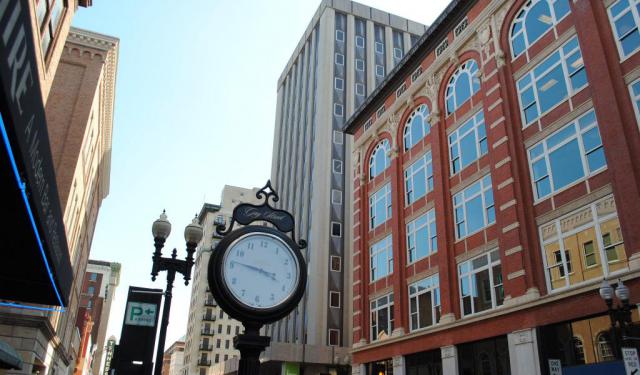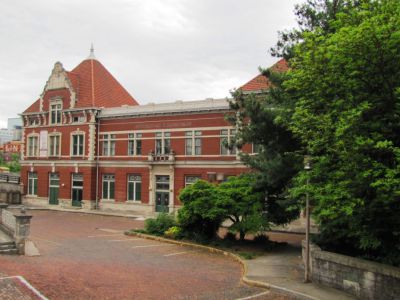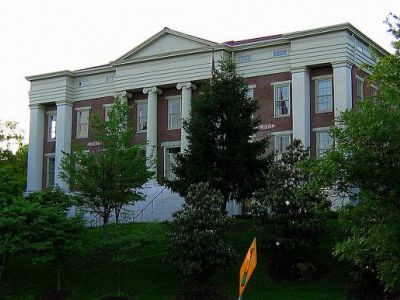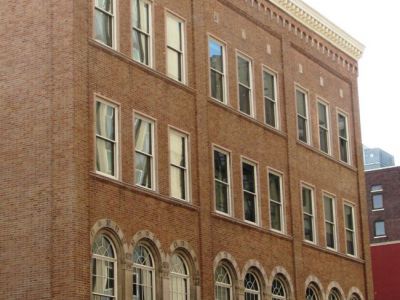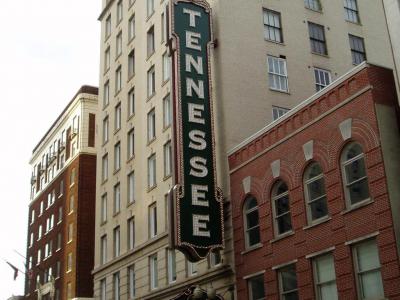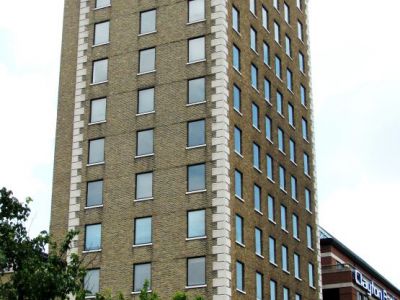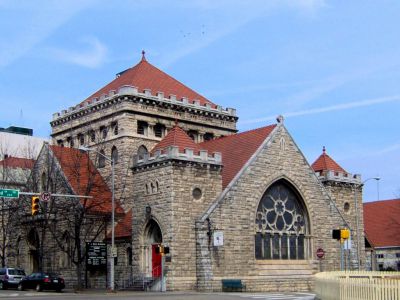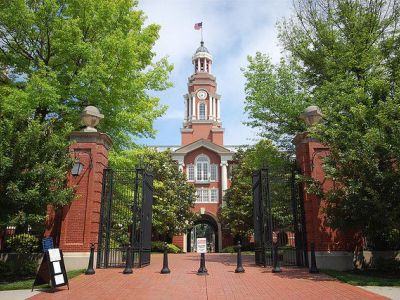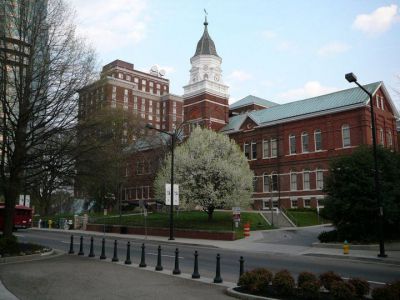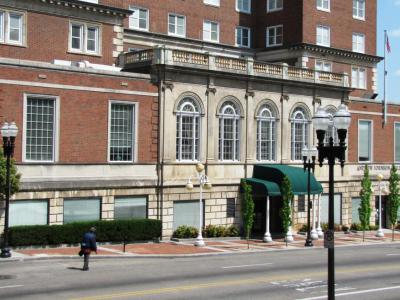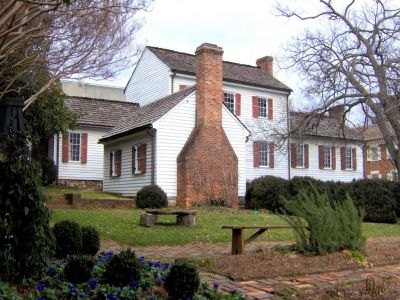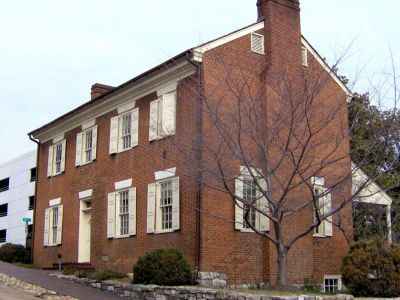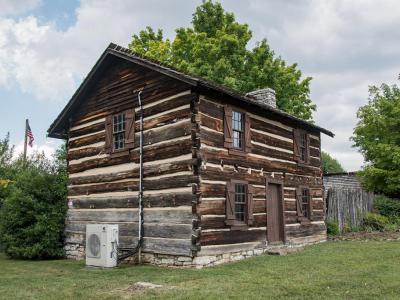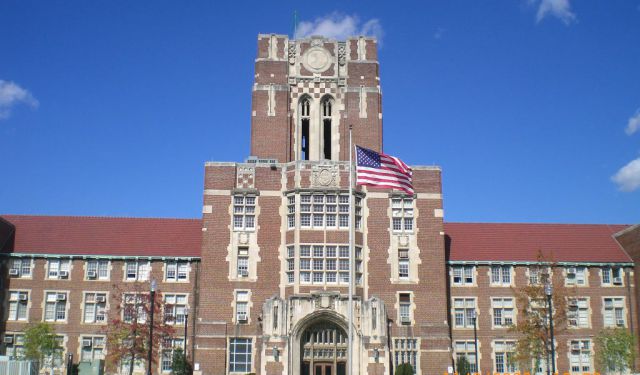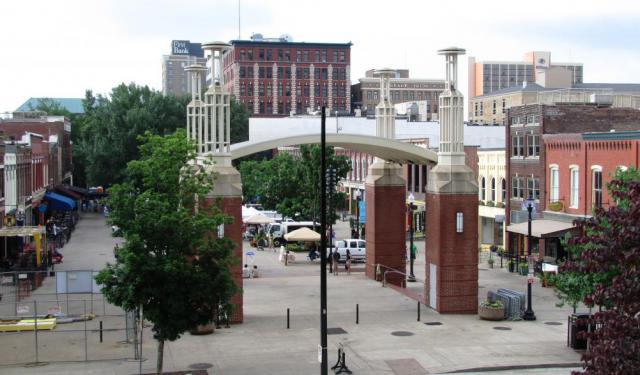Knoxville’s Historical Buildings (Self Guided), Knoxville
Knoxville is often referred to as "The Marble City" for the abundant supply of high-quality marble used in many of its buildings. Noting the wealth of well-preserved historic homes in the city, prominent American architect John Russell Pope even coined his own moniker for it – the "City of Houses".
Indeed, Knoxville's eventful and sometimes turbulent past, dating from the late 18th century, is vividly reflected in its architecture featuring a diverse range of styles inspired by various cultural and economic influences, from colonial roots to modernist aspirations.
One of the most notable pieces of local colonial architecture, the Blount Mansion, was built in 1792. In the mid-19th century, Knoxville experienced rapid growth, with many of its most iconic buildings constructed during that time. The Old City Hall, completed in 1845, is an excellent example of the Greek Revival style, featuring a prominent portico supported by Doric columns.
The late 1800s brought the rise of Victorian architecture, which is evident in the buildings such as the Louisville & Nashville Depot and James Park House. The Tennessee Theatre, first opened in 1928 as a movie palace, forms part of an older beautiful Spanish-Moorish-style building.
Knoxville boasts dozens of historic properties, deservedly listed for their architectural value. For your convenience, some of the most prominent ones are presented in this self-guided tour. Just take a walk and learn the stories behind these locations!
Indeed, Knoxville's eventful and sometimes turbulent past, dating from the late 18th century, is vividly reflected in its architecture featuring a diverse range of styles inspired by various cultural and economic influences, from colonial roots to modernist aspirations.
One of the most notable pieces of local colonial architecture, the Blount Mansion, was built in 1792. In the mid-19th century, Knoxville experienced rapid growth, with many of its most iconic buildings constructed during that time. The Old City Hall, completed in 1845, is an excellent example of the Greek Revival style, featuring a prominent portico supported by Doric columns.
The late 1800s brought the rise of Victorian architecture, which is evident in the buildings such as the Louisville & Nashville Depot and James Park House. The Tennessee Theatre, first opened in 1928 as a movie palace, forms part of an older beautiful Spanish-Moorish-style building.
Knoxville boasts dozens of historic properties, deservedly listed for their architectural value. For your convenience, some of the most prominent ones are presented in this self-guided tour. Just take a walk and learn the stories behind these locations!
How it works: Download the app "GPSmyCity: Walks in 1K+ Cities" from Apple App Store or Google Play Store to your mobile phone or tablet. The app turns your mobile device into a personal tour guide and its built-in GPS navigation functions guide you from one tour stop to next. The app works offline, so no data plan is needed when traveling abroad.
Knoxville’s Historical Buildings Map
Guide Name: Knoxville’s Historical Buildings
Guide Location: USA » Knoxville (See other walking tours in Knoxville)
Guide Type: Self-guided Walking Tour (Sightseeing)
# of Attractions: 14
Tour Duration: 2 Hour(s)
Travel Distance: 2.2 Km or 1.4 Miles
Author: Sandra
Sight(s) Featured in This Guide:
Guide Location: USA » Knoxville (See other walking tours in Knoxville)
Guide Type: Self-guided Walking Tour (Sightseeing)
# of Attractions: 14
Tour Duration: 2 Hour(s)
Travel Distance: 2.2 Km or 1.4 Miles
Author: Sandra
Sight(s) Featured in This Guide:
- Louisville and Nashville Depot
- Old Knoxville City Hall
- Fidelity Building
- Holston National Bank
- Tennessee Theatre, Burwell Building
- First Bank Building
- St. John's Cathedral
- James Park House
- Howard Baker Federal Courthouse
- Knox County Courthouse
- Andrew Johnson Hotel
- William Blount Mansion
- Craighead-Jackson House
- James White’s Fort
1) Louisville and Nashville Depot
The former train station known as the Louisville and Nashville Depot can be found at the northern end of Knoxville's World's Fair Park. Constructed in 1905, this impressive Victorian building was designed by Richard Montfort, the chief engineer of the L&N railroad. Until the L&N stopped offering passenger train service to Knoxville in 1968, the depot served as a significant passenger terminal. Thereafter, it housed L&N offices until 1975.
The L-shaped building was considered the "finest" station on the L&N's Cincinnati–Atlanta line, as it was the largest of its kind. Its distinctive features include an elegant northeast corner tower that rises three stories and is topped by a pitched, clay-tiled roof with decorated dormers. Another tower can be found at the end of the west wing, giving the building its chateau-like appearance. A wrap-around veranda provides access to the main floor on the south side of the building, while the north side of the west wing features restored frosted glass doors and glazed transoms.
During the 1982 World's Fair, the station was renovated and used for various purposes. Since it was close to the World's Fair Park, two restaurants, the L&N Seafood Grill, and a Ruby Tuesday restaurant, were situated on the lower floors. Additionally, the second-floor offices were converted into meeting rooms for the fair's VIPs. Nowadays, the L&N STEM Academy, a magnet high school that focuses on science, technology, engineering, and math, is housed in the building.
James Agee's Pulitzer Prize-winning novel, “A Death in the Family,” mentions the L&N Station in several scenes. In recognition of its architectural significance and contribution to Knoxville's transportation history, the building was added to the National Register of Historic Places in 1999.
The L-shaped building was considered the "finest" station on the L&N's Cincinnati–Atlanta line, as it was the largest of its kind. Its distinctive features include an elegant northeast corner tower that rises three stories and is topped by a pitched, clay-tiled roof with decorated dormers. Another tower can be found at the end of the west wing, giving the building its chateau-like appearance. A wrap-around veranda provides access to the main floor on the south side of the building, while the north side of the west wing features restored frosted glass doors and glazed transoms.
During the 1982 World's Fair, the station was renovated and used for various purposes. Since it was close to the World's Fair Park, two restaurants, the L&N Seafood Grill, and a Ruby Tuesday restaurant, were situated on the lower floors. Additionally, the second-floor offices were converted into meeting rooms for the fair's VIPs. Nowadays, the L&N STEM Academy, a magnet high school that focuses on science, technology, engineering, and math, is housed in the building.
James Agee's Pulitzer Prize-winning novel, “A Death in the Family,” mentions the L&N Station in several scenes. In recognition of its architectural significance and contribution to Knoxville's transportation history, the building was added to the National Register of Historic Places in 1999.
2) Old Knoxville City Hall
Constructed in the late 1840s, the Tennessee School for the Deaf and Dumb (now the Tennessee School for the Deaf) served as the original building complex of the Old City Hall. The complex comprises five interconnected buildings: the main building, a three-story structure completed in 1851, and four additions constructed between 1874 and 1899. The entire complex is situated atop a wooded knoll.
The central section's facade boasts a portico featuring four Ionic columns that support a large pediment, accessed by a marble staircase. Among the rear additions, one was designed in the Italian Renaissance style, while another contains Neoclassical elements. Over the years, the interiors of the buildings have undergone extensive modifications as the complex's role evolved.
From 1925 to 1980, the Old City Hall served as Knoxville's city hall. It has been listed on the National Register of Historic Places and documented by the Historic American Buildings Survey. Presently, the Duncan School of Law of Lincoln Memorial University occupies the complex.
The central section's facade boasts a portico featuring four Ionic columns that support a large pediment, accessed by a marble staircase. Among the rear additions, one was designed in the Italian Renaissance style, while another contains Neoclassical elements. Over the years, the interiors of the buildings have undergone extensive modifications as the complex's role evolved.
From 1925 to 1980, the Old City Hall served as Knoxville's city hall. It has been listed on the National Register of Historic Places and documented by the Historic American Buildings Survey. Presently, the Duncan School of Law of Lincoln Memorial University occupies the complex.
3) Fidelity Building
Constructed in 1871 for the wholesale firm Cowan, McClung, and Company, the Fidelity Building is a four-story, three-bay brick office complex situated in Knoxville. Originally designed in an Italianate style, the building featured a central pediment and balustrade, and Corinthian column-flanked storefronts. However, these elements were removed during extensive remodeling in 1929. It served as the home of Fidelity-Bankers Trust Company during the mid-20th century and has since been refurbished for office use.
The Fidelity's first-story Gay Street facade, reflecting the 1929 remodeling, features an ashlar veneer with an eagle-and-garland frieze atop a recessed entrance. Except for a one-story addition made in the early 1980s, the rear of the building remains mostly unaltered from its 1871 design. Inside, the building's central hall boasts gray marble walls and floors, square Corinthian columns, and a design that reflects the 1929 remodeling.
In recognition of its contribution to Knoxville's late-19th-century wholesaling industry and its remarkable architecture, the Fidelity Building was added to the National Register of Historic Places in 1984.
The Fidelity's first-story Gay Street facade, reflecting the 1929 remodeling, features an ashlar veneer with an eagle-and-garland frieze atop a recessed entrance. Except for a one-story addition made in the early 1980s, the rear of the building remains mostly unaltered from its 1871 design. Inside, the building's central hall boasts gray marble walls and floors, square Corinthian columns, and a design that reflects the 1929 remodeling.
In recognition of its contribution to Knoxville's late-19th-century wholesaling industry and its remarkable architecture, the Fidelity Building was added to the National Register of Historic Places in 1984.
4) Holston National Bank
The Holston National Bank commissioned the construction of a high-rise condominium named "The Holston" in 1913, which was the tallest building in Knoxville until the late 1920s when the Andrew Johnson Hotel was built a few blocks away. The building, designed by architect John Kevan Peebles, is the only Neoclassical Revival-style high-rise in the city.
The majority of the building is constructed from buff yellow brick, but the first three stories of the Gay Street and Clinch Avenue facades are covered with Tennessee marble. Despite being renovated in 1977, the Holston's interior retains several original features, such as the entrance foyer's vaulted ceiling with plaster rosettes and frieze adorned with triglyphs and metopes. The lobby previously contained Greek and Art Deco motifs, but these were removed during the renovation.
The Holston was added to the National Register of Historic Places in 1979 for its architecture and prominent position in the Knoxville skyline.
The majority of the building is constructed from buff yellow brick, but the first three stories of the Gay Street and Clinch Avenue facades are covered with Tennessee marble. Despite being renovated in 1977, the Holston's interior retains several original features, such as the entrance foyer's vaulted ceiling with plaster rosettes and frieze adorned with triglyphs and metopes. The lobby previously contained Greek and Art Deco motifs, but these were removed during the renovation.
The Holston was added to the National Register of Historic Places in 1979 for its architecture and prominent position in the Knoxville skyline.
5) Tennessee Theatre, Burwell Building (must see)
The Tennessee Theatre is a 1920s-era movie palace, located within the Burwell Building in downtown Knoxville. It occupies an annex added to the building in 1928, while the building itself was constructed in 1907. At a height of 166 feet (51 m), it remained Knoxville's tallest structure until 1912.
The theater first opened on October 1, 1928, and with nearly 2,000 seats in the auditorium, was billed as "Knoxville's Grand Entertainment Palace". Its interior was designed by Chicago architects Graven & Mayger in the Spanish-Moorish style, while also incorporating elements from different parts of the world, such as French-style chandeliers with Czechoslovakian crystals, Italian terrazzo flooring in the Grand Lobby, and Oriental influences in the carpet and drapery patterns. It also featured a beautiful Wurlitzer Organ. The theater was one of the first public buildings in Knoxville to have air conditioning.
Even though it was originally built as a “motion picture palace,” the Tennessee Theatre regularly played host to live music and weekend talent shows that gave stars of country music a chance to perform on its historic stage. Among them, Roy Acuff, dubbed the "King of Country Music", had his first public appearance here during a talent show. He admitted to having never won the first place, though, since the competition was too stiff.
Famous musicians across genres still grace the theater's stage to this day, making it one of the most significant standing country music landmarks in East Tennessee. In 1982, the theater was placed on the National Register of Historic Places.
The theater first opened on October 1, 1928, and with nearly 2,000 seats in the auditorium, was billed as "Knoxville's Grand Entertainment Palace". Its interior was designed by Chicago architects Graven & Mayger in the Spanish-Moorish style, while also incorporating elements from different parts of the world, such as French-style chandeliers with Czechoslovakian crystals, Italian terrazzo flooring in the Grand Lobby, and Oriental influences in the carpet and drapery patterns. It also featured a beautiful Wurlitzer Organ. The theater was one of the first public buildings in Knoxville to have air conditioning.
Even though it was originally built as a “motion picture palace,” the Tennessee Theatre regularly played host to live music and weekend talent shows that gave stars of country music a chance to perform on its historic stage. Among them, Roy Acuff, dubbed the "King of Country Music", had his first public appearance here during a talent show. He admitted to having never won the first place, though, since the competition was too stiff.
Famous musicians across genres still grace the theater's stage to this day, making it one of the most significant standing country music landmarks in East Tennessee. In 1982, the theater was placed on the National Register of Historic Places.
6) First Bank Building
The First Bank Building, also known as the Tennessee General (or simply the General) Building, is an office high riser on the northwest corner of Church Avenue and Market Street. Constructed in 1925, this was the first of its kind building in downtown Knoxville and the only high-riser designed by architect Charles I. Barber.
The 14-story "L-shaped" edifice contains roughly 50,000 square feet (4,600 m2) of office space. Its main facade, overlooking Market Street, consists of three arched openings, with the north opening leading to the general lobby, the south leading to the bank lobby, and the middle opening with a window. The bank lobby is the most elaborate interior room, featuring arched ceilings and a second-story mezzanine with a balustrade. The general lobby is distinguished by marble floors and bronze-plated elevator doors. Much of the building's interior was extensively remodeled during the early 1970s.
Over the years, the building has housed offices of numerous organizations. Presently, along with its anchor tenant, First Bank, it accommodates the Clayton Bank and Trust, the Legacy Parks Foundation, the Cornerstone Foundation of Knoxville, the Chapman Family Foundation, and the HealthCare 21 Business Coalition, not to mention multiple financial specialists and real estate agents.
In 1988, the First Bank Building was listed on the National Register of Historic Places for its architecture and role in Knoxville's commercial history.
The 14-story "L-shaped" edifice contains roughly 50,000 square feet (4,600 m2) of office space. Its main facade, overlooking Market Street, consists of three arched openings, with the north opening leading to the general lobby, the south leading to the bank lobby, and the middle opening with a window. The bank lobby is the most elaborate interior room, featuring arched ceilings and a second-story mezzanine with a balustrade. The general lobby is distinguished by marble floors and bronze-plated elevator doors. Much of the building's interior was extensively remodeled during the early 1970s.
Over the years, the building has housed offices of numerous organizations. Presently, along with its anchor tenant, First Bank, it accommodates the Clayton Bank and Trust, the Legacy Parks Foundation, the Cornerstone Foundation of Knoxville, the Chapman Family Foundation, and the HealthCare 21 Business Coalition, not to mention multiple financial specialists and real estate agents.
In 1988, the First Bank Building was listed on the National Register of Historic Places for its architecture and role in Knoxville's commercial history.
7) St. John's Cathedral
Saint John's Church was established in 1826, 35 years after Knoxville was founded. It was one of the congregations represented at the Primary Convention during the organization of the Diocese of Tennessee in Nashville in 1829. In May 1844, with 25 communicants, Saint John’s became the first mission from Eastern Tennessee to be admitted to the Diocese of Tennessee.
The original building was demolished in 1891 to create space for a larger facility, which was designed by J.W. Yost of Columbus, Ohio and completed in 1892. The stone church has a Latin cross form, but the nave, transepts, and apse are relatively small compared to the crossing, resulting in a spacious central area. The architectural style is Richardsonian Romanesque and features a slate roof, turrets, buttresses, and rose windows.
A fire in 1919 destroyed many of the original stained glass windows, but the church was promptly restored. In 1963, extensive renovation was carried out to create an undercroft under the nave floor. In 1986, Saint John’s was designated as the seat of the bishop for the newly created Diocese of East Tennessee.
The church office is adjacent to Saint John's Episcopal Cathedral. It is a two-story, classical brick building erected in 1857 by O. F. Hill to serve as both home and office. The original porch had Tuscan columns and extended the full width of the house, but it was eventually removed. The present porch is more modest. The house faces the James Park House across Cumberland Avenue to the south.
The original building was demolished in 1891 to create space for a larger facility, which was designed by J.W. Yost of Columbus, Ohio and completed in 1892. The stone church has a Latin cross form, but the nave, transepts, and apse are relatively small compared to the crossing, resulting in a spacious central area. The architectural style is Richardsonian Romanesque and features a slate roof, turrets, buttresses, and rose windows.
A fire in 1919 destroyed many of the original stained glass windows, but the church was promptly restored. In 1963, extensive renovation was carried out to create an undercroft under the nave floor. In 1986, Saint John’s was designated as the seat of the bishop for the newly created Diocese of East Tennessee.
The church office is adjacent to Saint John's Episcopal Cathedral. It is a two-story, classical brick building erected in 1857 by O. F. Hill to serve as both home and office. The original porch had Tuscan columns and extended the full width of the house, but it was eventually removed. The present porch is more modest. The house faces the James Park House across Cumberland Avenue to the south.
8) James Park House
Located in Knoxville, the James Park House is a significant historical structure. The L-shaped building stands two-and-a-half stories high, with a contemporary service wing situated at the back. Governor John Sevier laid the foundation in the 1790s, and Knoxville merchant and mayor James Park (1770–1853) completed the house in 1812. It is the second-oldest building in Downtown Knoxville, after the Blount Mansion.
To restore the house, Claussen utilized old photographs and architectural research. They added a picket fence around the property, reconstructed the Victorian-style front porch, rebuilt the front stairs, and reshaped the chimneys. Additionally, they restored an arched fireplace in the basement that had a design similar to the one in the Craighead-Jackson House.
The floors of the modern service wing have been painted with various historical maps of Knoxville. One restroom features a ceiling-to-floor safe, while another was modeled after the Red Sage restaurant's restroom in Washington, D.C.
The James Park House is registered on the National Register of Historic Places and serves as the headquarters for Gulf and Ohio Railways.
To restore the house, Claussen utilized old photographs and architectural research. They added a picket fence around the property, reconstructed the Victorian-style front porch, rebuilt the front stairs, and reshaped the chimneys. Additionally, they restored an arched fireplace in the basement that had a design similar to the one in the Craighead-Jackson House.
The floors of the modern service wing have been painted with various historical maps of Knoxville. One restroom features a ceiling-to-floor safe, while another was modeled after the Red Sage restaurant's restroom in Washington, D.C.
The James Park House is registered on the National Register of Historic Places and serves as the headquarters for Gulf and Ohio Railways.
9) Howard Baker Federal Courthouse
Occupying two city blocks in downtown Knoxville, the Howard Baker Federal Courthouse is a prominent landmark on the city's skyline. The extended four-story building complex is crowned with a beautiful tall, slender copper dome. It has an arched entrance on Cumberland Avenue, an impressive courtyard, and another entrance on Main Street.
Inspired by the work of McKim, Mead and White, this monumental red brick building with towers is a postmodern rendition of neo-Georgian architecture, featuring elaborate interior finishes and authentic construction materials.
Built in 1991, at a cost of $56 million, the initially three-story complex (250,000 sq. ft.) served as the corporate headquarters for Whittle Communications, the telecommunications company best known for 40 magazines and Channel One for schools. By 1995, the company had become defunct and sold the building to the federal government for just $22 million.
Acquiring the building served the government's needs all too well as it was conveniently located near the historic Knox County Courthouse across the street and the newer city-county building. All they had to do was add some courtrooms and governmental offices to the design. By 1998, the new federal Courthouse was ready, complete with a new four-story wing, upon which it was renamed after State Senator Howard H. Baker Jr.
Inspired by the work of McKim, Mead and White, this monumental red brick building with towers is a postmodern rendition of neo-Georgian architecture, featuring elaborate interior finishes and authentic construction materials.
Built in 1991, at a cost of $56 million, the initially three-story complex (250,000 sq. ft.) served as the corporate headquarters for Whittle Communications, the telecommunications company best known for 40 magazines and Channel One for schools. By 1995, the company had become defunct and sold the building to the federal government for just $22 million.
Acquiring the building served the government's needs all too well as it was conveniently located near the historic Knox County Courthouse across the street and the newer city-county building. All they had to do was add some courtrooms and governmental offices to the design. By 1998, the new federal Courthouse was ready, complete with a new four-story wing, upon which it was renamed after State Senator Howard H. Baker Jr.
10) Knox County Courthouse
Constructed between 1884 and 1886, the Knox County Courthouse, a stunning 2.5-story brick building, is the fourth of its kind to be built. It boasts a combination of architectural styles, such as Colonial elements in its clock tower and Gothic elements in the balcony and porch, featuring qua-trefoil patterns. While much of the interior has been altered, the exterior has remained impressively intact.
Initially serving as a courthouse until the completion of the City-County Building on Hill Avenue in 1980, plans to demolish the courthouse were set in motion. However, thanks to the efforts of Knox County Executive Dwight Kessel and a preservation movement, the building was saved from destruction. Currently, it houses several county offices, including that of the county clerk. Furthermore, the courthouse lawn is home to the final resting place of John Sevier, Tennessee's first governor.
As a testament to its significant role in the country's political history and remarkable architecture, the Knox County Courthouse was eventually added to the National Register of Historic Places.
Initially serving as a courthouse until the completion of the City-County Building on Hill Avenue in 1980, plans to demolish the courthouse were set in motion. However, thanks to the efforts of Knox County Executive Dwight Kessel and a preservation movement, the building was saved from destruction. Currently, it houses several county offices, including that of the county clerk. Furthermore, the courthouse lawn is home to the final resting place of John Sevier, Tennessee's first governor.
As a testament to its significant role in the country's political history and remarkable architecture, the Knox County Courthouse was eventually added to the National Register of Historic Places.
11) Andrew Johnson Hotel
The Andrew Johnson Building is a high-rise office complex in downtown Knoxville, completed in 1930. At 203 feet (62 m) it was the city's tallest building and the cornerstone of the downtown skyline for half a century, from 1928 to 1978.
The total of its 18-story height is made up of 15 floors, a mezzanine, and a two-story penthouse. The building is rectangular, with a recess running up the middle of the west facade. The ground floor extends out beyond the rest of the building to provide a base for the unique second story, which includes an open-air pavilion. Sitting at the very top of the building is the penthouse, which is seven bays wide and adorned with brick Ionic pilasters.
Originally home to the Andrew Johnson Hotel, this building has seen many esteemed guests over the years. Among them were Amelia Earhart (American aviation pioneer who stayed at the Andrew Johnson in 1936 – the year before her disappearance), jazz legend Duke Ellington, and the great Russian composer and pianist, Sergei Rachmaninoff, who stayed here after his performance at the University of Tennessee Alumni Hall in 1943.
Among other noteworthy personalities logging at the Andrew Johnson was the country music star, Hank Williams, who spent here the last few hours of his life. On New Year’s Eve of 1952, he checked into the hotel for what would be his final day. Though Williams was pronounced dead in West Virginia some time later, many believe that he had already been dead when leaving the hotel. Witnesses said, Williams was carried out semiconscious, apparently injected with some painkillers, to his automobile by a chauffeur and a hotel employee, who wondered about Williams's condition, and later suggested that he might have been dead at that point. Hank Williams was only 29.
In 1980, the Andrew Johnson Building was added to the National Register of Historic Places. Currently, it is used for office space by Knox County.
The total of its 18-story height is made up of 15 floors, a mezzanine, and a two-story penthouse. The building is rectangular, with a recess running up the middle of the west facade. The ground floor extends out beyond the rest of the building to provide a base for the unique second story, which includes an open-air pavilion. Sitting at the very top of the building is the penthouse, which is seven bays wide and adorned with brick Ionic pilasters.
Originally home to the Andrew Johnson Hotel, this building has seen many esteemed guests over the years. Among them were Amelia Earhart (American aviation pioneer who stayed at the Andrew Johnson in 1936 – the year before her disappearance), jazz legend Duke Ellington, and the great Russian composer and pianist, Sergei Rachmaninoff, who stayed here after his performance at the University of Tennessee Alumni Hall in 1943.
Among other noteworthy personalities logging at the Andrew Johnson was the country music star, Hank Williams, who spent here the last few hours of his life. On New Year’s Eve of 1952, he checked into the hotel for what would be his final day. Though Williams was pronounced dead in West Virginia some time later, many believe that he had already been dead when leaving the hotel. Witnesses said, Williams was carried out semiconscious, apparently injected with some painkillers, to his automobile by a chauffeur and a hotel employee, who wondered about Williams's condition, and later suggested that he might have been dead at that point. Hank Williams was only 29.
In 1980, the Andrew Johnson Building was added to the National Register of Historic Places. Currently, it is used for office space by Knox County.
12) William Blount Mansion
The Blount Mansion, also known as William Blount Mansion, is the former home of William Blount (1749–1800), the only territorial governor of the Southwest Territory (the Territory South of the Ohio River, created in 1790). Originally a North Carolina businessman and land speculator, Blount was appointed governor by President George Washington. A signer of the United States Constitution, he was also instrumental in the inauguration of Tennessee as the 16th state and later served as a U.S. Senator from Tennessee.
Blount lived on this property together with his family and 10 African-American slaves. Much of the Tennessee Constitution was drafted in Governor Blount's office at the mansion, from 1792 to 1796. Tennessee state historian John Trotwood Moore once called Blount Mansion "the most important historical spot in Tennessee."
Blount's reasons for building an elaborate frame house on the frontier were twofold. First, it would act as a de facto capitol of the Southwest Territory, and thus would need to command the respect of visiting delegations. Second, Blount wanted to fulfill a promise he made to his wife, Mary Grainger Blount, to build a home comparable to their lavish North Carolina home.
Constructed between 1792 and 1830, the graceful two-story house with a single bedroom upstairs is a wood-frame, hall-parlor home sheathed in wood siding, built with materials brought from North Carolina in an era when most homes in Tennessee were log cabins.
By 1925, the house had deteriorated and was on a brink of demolition. Fortunately, the purpose-established Blount Mansion Association, following a massive publicity campaign, managed to raise enough money to purchase the house in 1930. Committed to its preservation and a positive comprehension of national, regional and local history, the Association has since maintained the property as a museum and made numerous renovations to restore it to its late 18th-century appearance. In the 1960s, the mansion was designated a National Historic Landmark and in 1966 included in the National Register of Historic Places.
Blount lived on this property together with his family and 10 African-American slaves. Much of the Tennessee Constitution was drafted in Governor Blount's office at the mansion, from 1792 to 1796. Tennessee state historian John Trotwood Moore once called Blount Mansion "the most important historical spot in Tennessee."
Blount's reasons for building an elaborate frame house on the frontier were twofold. First, it would act as a de facto capitol of the Southwest Territory, and thus would need to command the respect of visiting delegations. Second, Blount wanted to fulfill a promise he made to his wife, Mary Grainger Blount, to build a home comparable to their lavish North Carolina home.
Constructed between 1792 and 1830, the graceful two-story house with a single bedroom upstairs is a wood-frame, hall-parlor home sheathed in wood siding, built with materials brought from North Carolina in an era when most homes in Tennessee were log cabins.
By 1925, the house had deteriorated and was on a brink of demolition. Fortunately, the purpose-established Blount Mansion Association, following a massive publicity campaign, managed to raise enough money to purchase the house in 1930. Committed to its preservation and a positive comprehension of national, regional and local history, the Association has since maintained the property as a museum and made numerous renovations to restore it to its late 18th-century appearance. In the 1960s, the mansion was designated a National Historic Landmark and in 1966 included in the National Register of Historic Places.
13) Craighead-Jackson House
The Craighead-Jackson House, a two-story white brick structure with a basement, holds significant historical value. Its first level encompasses a central hallway spanning the house's east to west, with two main entrances, a staircase, a sitting room on the north side, and a parlor on the south. Upstairs, there are two bedrooms, with the southern one slightly larger than the northern one. The basement features a dining room and a large "unfinished" space, with chimneys located at the house's north and south ends. A small porch adorns the west-facing entrance, and a covered porch is at the back.
In 1818, John Craighead (1783–1826), a Knoxville city alderman and an elder of the First Presbyterian Church, purchased the land on which the house stands. The same year, he built the house and resided there with his family until 1855. In the late 1850s, the house passed to George Jackson, a Knoxville physician. Local legend has it that one of Jackson's servants, working in the kitchen, perished in a fire caused by her skirt catching fire, and her ghost haunts the building.
Today, the Craighead-Jackson House is registered on the National Register of Historic Places.
In 1818, John Craighead (1783–1826), a Knoxville city alderman and an elder of the First Presbyterian Church, purchased the land on which the house stands. The same year, he built the house and resided there with his family until 1855. In the late 1850s, the house passed to George Jackson, a Knoxville physician. Local legend has it that one of Jackson's servants, working in the kitchen, perished in a fire caused by her skirt catching fire, and her ghost haunts the building.
Today, the Craighead-Jackson House is registered on the National Register of Historic Places.
14) James White’s Fort (must see)
James White's Fort, or White's Fort for short, is an 18th-century pioneer settlement that gave start to Knoxville. The fort was built in 1786 by the city's founder James White who was born in 1747 in North Carolina and was a militia officer fighting in the American Revolutionary War. In 1783, he led an expedition into the upper Tennessee Valley, where he discovered the site of future Knoxville.
The fort itself began when James White was granted for his service 1,000 acres of land and built a two-story log cabin near what is now the corner of State Street and Clinch Avenue. The surrounding trees have been cut and replaced with gardens and farms. The cabin soon became the center of a cluster of fortified log structures known as White's Fort.
When William Blount, the governor of the Southwest Territory, moved the territorial capital to White's Fort in 1791, he renamed it Knoxville in honor of Henry Knox, the American Revolutionary War general and Washington's Secretary of War. That same year, James White sold the land and donated lots for a permanent city, Knoxville. He lived in the fort until 1793. White died on August 14, 1821, and was buried next to his wife in the First Presbyterian Church Cemetery at 620 State Street in Knoxville.
The original cabin later became the kitchen of the Kennedy House, which was built in the 1830s. In 1906, when the Kennedy house was demolished for development, Isaiah Ford bought the log structure and moved it to Woodlawn Pike. It was purchased again in 1960 by the City Association of Women's Clubs; in 1968, the timbers were reconstructed as part of the fort. The fort still stands on a bluff near its original location. Seven log cabins and the stockade fence remain. The cabins display original pioneer artifacts and furnishings depicting the frontier lifestyle, making it one of the most visited historical sites in Knoxville.
The fort was opened to the public as a museum in 1970.
The fort itself began when James White was granted for his service 1,000 acres of land and built a two-story log cabin near what is now the corner of State Street and Clinch Avenue. The surrounding trees have been cut and replaced with gardens and farms. The cabin soon became the center of a cluster of fortified log structures known as White's Fort.
When William Blount, the governor of the Southwest Territory, moved the territorial capital to White's Fort in 1791, he renamed it Knoxville in honor of Henry Knox, the American Revolutionary War general and Washington's Secretary of War. That same year, James White sold the land and donated lots for a permanent city, Knoxville. He lived in the fort until 1793. White died on August 14, 1821, and was buried next to his wife in the First Presbyterian Church Cemetery at 620 State Street in Knoxville.
The original cabin later became the kitchen of the Kennedy House, which was built in the 1830s. In 1906, when the Kennedy house was demolished for development, Isaiah Ford bought the log structure and moved it to Woodlawn Pike. It was purchased again in 1960 by the City Association of Women's Clubs; in 1968, the timbers were reconstructed as part of the fort. The fort still stands on a bluff near its original location. Seven log cabins and the stockade fence remain. The cabins display original pioneer artifacts and furnishings depicting the frontier lifestyle, making it one of the most visited historical sites in Knoxville.
The fort was opened to the public as a museum in 1970.
Walking Tours in Knoxville, Tennessee
Create Your Own Walk in Knoxville
Creating your own self-guided walk in Knoxville is easy and fun. Choose the city attractions that you want to see and a walk route map will be created just for you. You can even set your hotel as the start point of the walk.
University of Tennessee Walking Tour
Founded in 1794 as William Blount College, The University of Tennessee (UT) in Knoxville is one of the oldest public universities in the United States. Nowadays, the UT flagship institution features a mix of historic and modern sites which draw many a visitor to the city.
The campus covers nearly 600 acres in downtown’s west end, including over 200 buildings and a faculty of more than 1,700... view more
Tour Duration: 2 Hour(s)
Travel Distance: 3.0 Km or 1.9 Miles
The campus covers nearly 600 acres in downtown’s west end, including over 200 buildings and a faculty of more than 1,700... view more
Tour Duration: 2 Hour(s)
Travel Distance: 3.0 Km or 1.9 Miles
Downtown Knoxville Walking Tour
A small town with big-city amenities and a vibrant music scene (a mix of country, bluegrass, and rock), Knoxville, or K-Town as it's popularly shortened by locals, is also often referred to as “the Gateway to the Great Smoky Mountains,” for its proximity to the national park area, whose marble quarries, in the past, gave it another moniker, The Marble City.
Knoxville was founded in... view more
Tour Duration: 2 Hour(s)
Travel Distance: 2.3 Km or 1.4 Miles
Knoxville was founded in... view more
Tour Duration: 2 Hour(s)
Travel Distance: 2.3 Km or 1.4 Miles
The Most Popular Cities
/ view all
